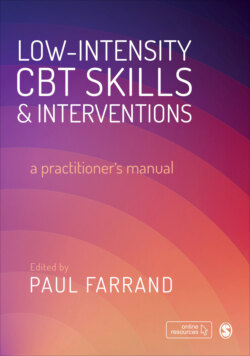Читать книгу Low-intensity CBT Skills and Interventions - Группа авторов - Страница 38
На сайте Литреса книга снята с продажи.
Therapeutic Drift within CBT Self-Help Interventions
ОглавлениеThe genesis of self-help as a concept informing self-help books (Smiles, 1859) precedes the development of CBT self-help. Consequently, CBT has been adapted in many different ways to inform the content of the self-help interventions leading to significant heterogeneity. This has resulted in some CBT self-help interventions being more representative of HICBT by adopting multi-strand interventions, longitudinal formulations and techniques to address more enduring cognitive distortions (Beck, 1995). For example, a commonly adopted written CBT self-help book for depression, Overcoming Depression, (Gilbert, 2009) includes techniques such as cognitive restructuring but as part of a multi-strand approach including a compassion focus and addressing other difficulties that can be co-morbid with depression, such as anger. Additionally, multi-strand interventions have been adopted within iCBT programmes proposed to be LICBT with support provided by LICBT practitioners (Richards et al., 2018). For example, ‘Space from Depression’ includes techniques for depression such as behavioural activation, self-control desensitisation and cognitive restructuring alongside techniques used to challenge core beliefs. NICE guidelines for depression are cited as the justification for the approach taken. However, these guidelines highlight these techniques when used as part of a multi-strand approach within HICBT.
LICBT self-help interventions adopting a multi-strand approach is therefore inconsistent with a single-strand approach associated with LICBT. They can drift away from the focus of the difficulties presented in the here and now and address a longitudinal formulation and require a psychological practitioner workforce to drift from the LICBT clinical method.
